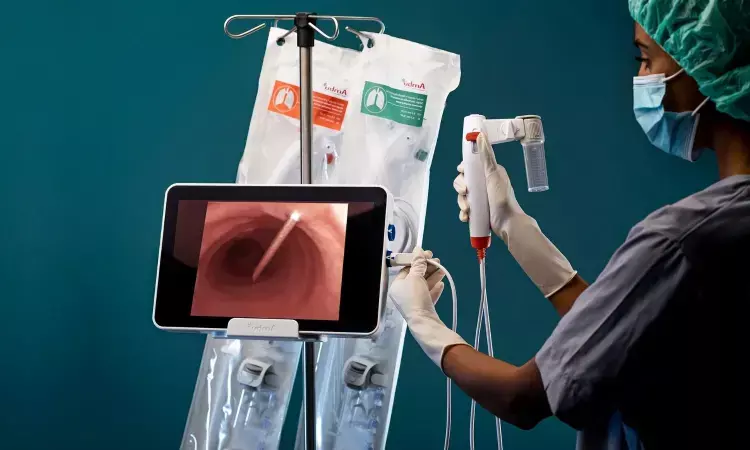- Home
- Medical news & Guidelines
- Anesthesiology
- Cardiology and CTVS
- Critical Care
- Dentistry
- Dermatology
- Diabetes and Endocrinology
- ENT
- Gastroenterology
- Medicine
- Nephrology
- Neurology
- Obstretics-Gynaecology
- Oncology
- Ophthalmology
- Orthopaedics
- Pediatrics-Neonatology
- Psychiatry
- Pulmonology
- Radiology
- Surgery
- Urology
- Laboratory Medicine
- Diet
- Nursing
- Paramedical
- Physiotherapy
- Health news
- Fact Check
- Bone Health Fact Check
- Brain Health Fact Check
- Cancer Related Fact Check
- Child Care Fact Check
- Dental and oral health fact check
- Diabetes and metabolic health fact check
- Diet and Nutrition Fact Check
- Eye and ENT Care Fact Check
- Fitness fact check
- Gut health fact check
- Heart health fact check
- Kidney health fact check
- Medical education fact check
- Men's health fact check
- Respiratory fact check
- Skin and hair care fact check
- Vaccine and Immunization fact check
- Women's health fact check
- AYUSH
- State News
- Andaman and Nicobar Islands
- Andhra Pradesh
- Arunachal Pradesh
- Assam
- Bihar
- Chandigarh
- Chattisgarh
- Dadra and Nagar Haveli
- Daman and Diu
- Delhi
- Goa
- Gujarat
- Haryana
- Himachal Pradesh
- Jammu & Kashmir
- Jharkhand
- Karnataka
- Kerala
- Ladakh
- Lakshadweep
- Madhya Pradesh
- Maharashtra
- Manipur
- Meghalaya
- Mizoram
- Nagaland
- Odisha
- Puducherry
- Punjab
- Rajasthan
- Sikkim
- Tamil Nadu
- Telangana
- Tripura
- Uttar Pradesh
- Uttrakhand
- West Bengal
- Medical Education
- Industry
High-flow nasal cannula oxygenation bests apnoeic oxygenation during Foreign body removal by rigid bronchoscopy

Bronchoscopy often results in hypoxemia. Throughout the process, the partial pressure of oxygen (PaO2) typically declines by 20 mmHg, with the greatest reduction occurring during bronchoalveolar lavage. In order to prevent bronchoscopy-induced hypoxaemia, oxygen may be supplied by low or high gas fluxes. For oxygen treatment, the high-flow nasal cannula (HFNC) was launched recently. This device distributes heated, humidified air with a predetermined percentage of inspired oxygen (FiO2) and a maximum flow rate of 60 L/min through nasal prongs. It maintains blood oxygenation throughout the apnea stage of bronchoscopy, provides a flow-dependent positive airway pressure, and increases end-expiratory lung capacity to promote oxygenation. A recently published research compared the safety and effectiveness of oxygenation using a high-frequency nasal cannula (HFNC) to the usual apnoeic oxygenation approach during foreign body (FB) removal using a rigid bronchoscope.
Subjects slated for FB removal using a rigid bronchoscope participated in a prospective, blinded, randomized, controlled experiment. Men and women between the ages of 10 and 40 were considered for inclusion. The main result was the lowest oxygen saturation level measured by pulse oximeter during the surgery, while the secondary outcome was the incidence of postoperative atelectasis. Nearly 64 individuals were randomly assigned to either the HFNC oxygenation group (N = 32) or the apnoeic oxygenation group (N = 32). There were no statistically significant variations in age, gender, weight, or cardiovascular characteristics between the study groups. At various periods, intraoperative oxygen saturation was 4 percent greater in the HFNC group. The end-tidal carbon dioxide measured during induction and 15 minutes after termination did not differ significantly between the two groups; however, it was significantly higher in the apneic oxygenation group immediately after the procedure, 5 minutes after termination, and 10 minutes after termination. No deleterious effects were recorded as a result of the elevated end-tidal carbon dioxide levels.
Gas exchange is often reduced during bronchoscopy due to sedation and mismatching between ventilation and perfusion. Atelectasis may develop from increased airway resistance caused by the bronchoscope and gas aspiration via it. Positive end-expiratory pressure (PEEP) supplied by the HFNC seems to promote alveolar recruitment, increase functional residual capacity, and raise intrathoracic pressure during HFNC usage. In patients having rigid bronchoscopy for FB removal, HFNC was superior to apnoeic oxygenation in obtaining oxygen saturations greater than 92%. HFNC increased oxygen saturation and decreased end-tidal carbon dioxide levels in comparison to normal apneic oxygenation. Additionally, it resulted in fewer interruptions of the process and fewer bronchoscopy trial attempts.
References –
Twab, Samar M. Abdel,; Abdo, Fagr F.; Derh, Maha S. El High-flow nasal cannula oxygenation in comparison with apnoeic oxygenation during foreign body removal by rigid bronchoscopy: A randomised controlled trial, Indian Journal of Anaesthesia: May 2022 - Volume 66 - Issue 5 - p 344-349
doi: 10.4103/ija.ija_782_21
MBBS, MD (Anaesthesiology), FNB (Cardiac Anaesthesiology)
Dr Monish Raut is a practicing Cardiac Anesthesiologist. He completed his MBBS at Government Medical College, Nagpur, and pursued his MD in Anesthesiology at BJ Medical College, Pune. Further specializing in Cardiac Anesthesiology, Dr Raut earned his FNB in Cardiac Anesthesiology from Sir Ganga Ram Hospital, Delhi.
Dr Kamal Kant Kohli-MBBS, DTCD- a chest specialist with more than 30 years of practice and a flair for writing clinical articles, Dr Kamal Kant Kohli joined Medical Dialogues as a Chief Editor of Medical News. Besides writing articles, as an editor, he proofreads and verifies all the medical content published on Medical Dialogues including those coming from journals, studies,medical conferences,guidelines etc. Email: drkohli@medicaldialogues.in. Contact no. 011-43720751


